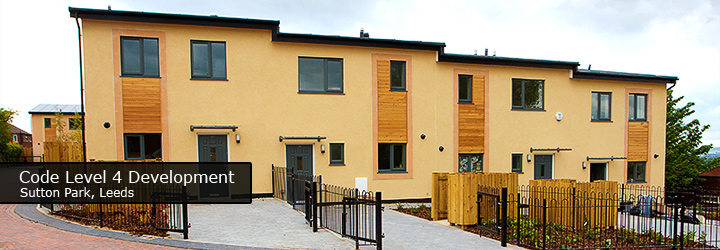Following a fundamental review of technical housing standards, the government has withdrawn the Code for Sustainable Homes, aside from the management of legacy cases. View further information on GOV.UK.
An A+ Green Guide to Specification Rating
The Amvic ICF system has also been awarded an A+ by the BRE under its Green Guide to Specification assessment scheme.
To quote the BRE, ‘In the Green Guide, materials and components are assessed in terms of their environmental impacts, within comparable specifications, across their entire life cycles. This accessible and reliable information will help all those involved in the design, construction and management of buildings to reduce the environmental impacts of their properties.’
An A+ demonstrates that the Amvic ICF system is one of the most environmentally friendly and sustainable ways that you can build today and is completely compliant with the code for sustainable homes.

So how is Amvic ICF sustainable?
Embodied Energy
Concrete, a major element of ICF construction, hasn’t traditionally faired that well in ‘Eco’ terms because of the high amount of energy needed to produce cement. However, recent developments in concrete technology has changed this, for example, a typical structural concrete mix using 50% ground granulated blast-furnace slag as a cement replacement now has embodied CO2 in the order of just 12% of what would have been the original 100% cement figure.
Similarly, expanded polystyrene (EPS), a natural by-product of the petroleum refining process and the other major element of ICF construction, when used for insulation purposes will recoup the CO2 generated during its production within the first week of the building’s operation, simply by reducing occupant heating/cooling demands. EPS is also HCFC and CFC free.
The Code For Sustainable Homes
As can be seen, if you are looking to engage in a construction project in within the area, the Amvic ICF is completely compliant with the code for sustainable homes. As mentioned earlier, sustainability decisions must consider the lifetime of a building and not just the initial impacts.
In the UK, 10% of our CO2 emissions come from the construction of our built environment. But a massive 50% comes from actually using our buildings, 27% of which is residential use.
And this is where ICF construction really comes into its own, both in terms of its durability and its energy efficiency, proving that it is a truly sustainable modern method of construction (MMC).
Lifetime Savings
The following points are considered as key aspects to consider when developing sustainable construction:-
- Thermal Mass
- Durability
- Fire resistance
- Acoustic performance
- Flood resistance
- Maintenance
- Security
- Air tightness
The way in which polystyrene and concrete is combined in ICF construction means this system provides outstanding performance levels for each of these key points.
Thermal Mass
Concrete construction naturally has a high thermal mass, which is the ability of a material to store excess heat energy during the day. This heat energy is then released back into the building at night as it begins to cool. The strength of an ICF construction allows for concrete elements to be used internally throughout, including all floors and internal walls, maximising the thermal mass available.
Durability
An Amvic ICF structure is built to last. Concrete is inherently durable, and when cast within the Amvic ICF system, it cures without suffering exposure to extreme temperature variances. This results in a far higher strength of set initially, but the insulation provided by the polystyrene also permanently reduces the stress on the concrete caused by thermal expansion and contraction, enhancing its lifetime well beyond standard masonry construction.
Fire Resistance
Concrete construction is extremely resilient to fire damage. Amvic ICF walls have fire-performance ratings of up to 3 hours.
Sound Insulation
The mass of the concrete within the Amvic ICF system makes for amazing sound absorption with typical sound reduction of 52 dB across the finished wall.
Flood Resistance
Neither concrete nor expanded polystyrene rot or suffer from water damage, making ICF construction extremely resilient to flood damage. The monolithic structure is much better at resisting water ingress.
Maintenance
The physical and chemical constancy of both concrete and EPS in an ICF building means there is practically no maintenance required to the structure at all.
Security
The inherent strength of the solid concrete core makes an Amvic ICF structure safe and secure. This can be further enhanced by reinforcing the concrete where necessary.
Air-tightness
Amvic ICF is extremely airtight, with a typical structure experiencing less than 1 air change per hour (ACH). Because this is a poured concrete method of construction the structure is effectively monolithic, thus air-leakage is reduced to an absolute minimum.
Recyclability
Even though an Amvic ICF structure has a very long lifespan, at the end of the building’s lifetime, both the polystyrene and the concrete can be fully recycled, along with the plastic bridges which are already made from 100% recycled plastic.
Further Information
You may also find the following websites of interest regarding sustainability:- These also apply for the code for sustainable homes.
